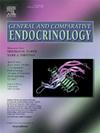斑马鱼代谢组织中的脂肪量和肥胖相关基因及同源转录因子iriquois-3 mRNA谱系受摄食和食物剥夺的调节。
IF 1.7
3区 医学
Q3 ENDOCRINOLOGY & METABOLISM
引用次数: 0
摘要
脂肪量和肥胖相关基因(FTO)与肥胖密切相关,它与同源转录因子iriquois-3(IRX3)有功能上的联系。在哺乳动物中,FTO 和 IRX3 参与食物摄入和新陈代谢的调节。本研究旨在确定 FTO 和 IRX3 是否会受到进食和食物不可获性的影响。FTO和IRX3 mRNA和蛋白质广泛分布于所有受检组织,包括大脑、肌肉、肠道和肝脏。进食后1小时,在雌雄斑马鱼的代谢组织中观察到餐后FTO和IRX3 mRNA丰度的增加。同时,它们在大脑和肠道中的表达量在喂食后 3 小时下降,达到餐前水平。此外,在断食 7 天后,FTO 和 IRX3 mRNA 在受检组织中的丰度增加,但在进食 24 小时后则大幅下降。综上所述,我们发现 FTO 和 IRX3 都是斑马鱼的进食敏感基因。空腹诱导的增加表明 FTO 和 IRX3 在斑马鱼中可能具有食欲调节作用。这些发现突显了 FTO 和 IRX3 在斑马鱼食欲和代谢调节中的重要性。本文章由计算机程序翻译,如有差异,请以英文原文为准。
Fat mass and obesity associated gene and homeobox transcription factor iriquois-3 mRNA profiles in the metabolic tissues of zebrafish are modulated by feeding and food deprivation
Fat mass and obesity associated gene (FTO) has been strongly associated with obesity, and it is functionally linked to the homeobox transcription factor iriquois-3 (IRX3). In mammals, FTO and IRX3 are involved in the regulation of food intake and metabolism. This study aimed to determine whether FTO and IRX3 are affected by feeding and food unavailability. FTO and IRX3 mRNA and protein were found widely distributed in all tissues examined, including the brain, muscle, gut, and liver. Postprandial increase in the abundance of FTO and IRX3 mRNAs was observed in metabolic tissues of both male and female zebrafish at 1 h post-feeding. Meanwhile, their expression in the brain and gut decreased at 3 h post-feeding, reaching preprandial levels. Additionally, FTO and IRX3 mRNA abundance in examined tissues increased after 7 days of food deprivation, but substantially decreased after refeeding for 24 h. In summary, we report that both FTO and IRX3 are meal-sensitive genes in zebrafish. The fasting-induced increase suggests a possible appetite regulatory role for FTO and IRX3 in zebrafish. These findings highlight the importance of FTO and IRX3 in appetite and metabolic regulation in zebrafish.
求助全文
通过发布文献求助,成功后即可免费获取论文全文。
去求助
来源期刊

General and comparative endocrinology
医学-内分泌学与代谢
CiteScore
5.60
自引率
7.40%
发文量
120
审稿时长
2 months
期刊介绍:
General and Comparative Endocrinology publishes articles concerned with the many complexities of vertebrate and invertebrate endocrine systems at the sub-molecular, molecular, cellular and organismal levels of analysis.
 求助内容:
求助内容: 应助结果提醒方式:
应助结果提醒方式:


